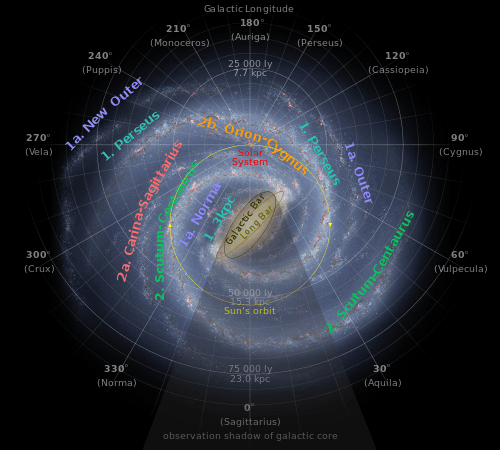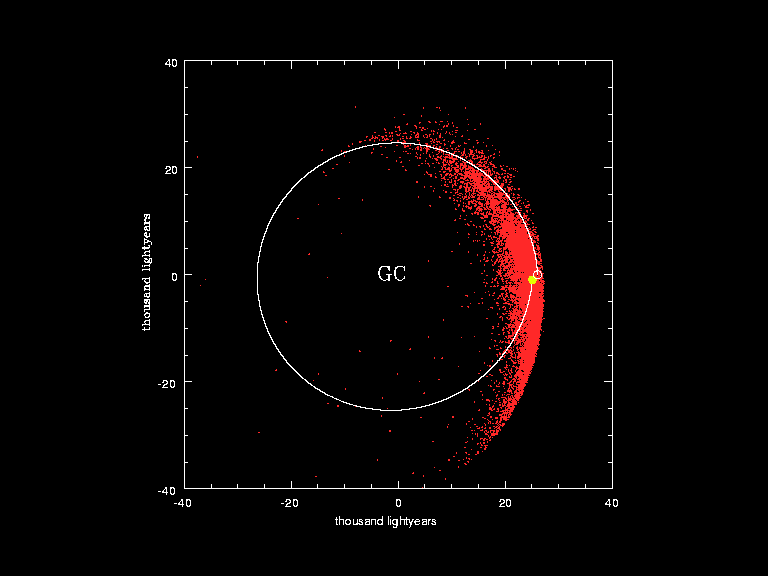Galactic year
Approximate orbit of the Sun (yellow circle) around the Galactic Centre
The galactic year, also known as a cosmic year, is the duration of time required for the Solar System to orbit once around the center of the Milky Way Galaxy.[1] Estimates of the length of one orbit range from 225 to 250 million terrestrial years.[2] The Solar System is traveling at an average speed of 828,000 km/h (230 km/s) or 514,000 mph (143 mi/s) within its trajectory around the galactic center,[3] a speed at which an object could circumnavigate the Earth's equator in 2 minutes and 54 seconds; that speed corresponds to approximately one 1300th of the speed of light.
The galactic year provides a conveniently usable unit for depicting cosmic and geological time periods together. By contrast, a "billion-year" scale does not allow for useful discrimination between geologic events, and a "million-year" scale requires some rather large numbers.[4]
Timeline of the universe and Earth's history in galactic years
The following list assumes that 1 galactic year is 225 million years.
| About 61 galactic years ago | Big Bang |
| About 54 galactic years ago | Birth of the Milky Way |
| 18.4 galactic years ago | Birth of the Sun |
| 17–18 galactic years ago | Oceans appear on Earth |
| 15 galactic years ago | Life begins on Earth |
| 14 galactic years ago | Prokaryotes appear |
| 13 galactic years ago | Bacteria appear |
| 10 galactic years ago | Stable continents appear |
| 7 galactic years ago | Eukaryotes appear |
| 6.8 galactic years ago | Multicellular organisms appear |
| 2.8 galactic years ago | Cambrian explosion occurs |
| 2 galactic years ago | The first brain structure appeared in worms |
| 1 galactic year ago | Permian–Triassic extinction event |
| 0.26 galactic years ago | Cretaceous–Paleogene extinction event |
| 0.001 galactic years ago | Appearance of modern humans |
| Present day | |
|---|---|
| 1 galactic year from now | All the continents on Earth may fuse into a supercontinent. Three potential arrangements of this configuration have been dubbed Amasia, Novopangaea, and Pangaea Ultima[5] |
| 2–3 galactic years from now | Tidal acceleration moves the Moon far enough from Earth that total solar eclipses are no longer possible |
| 4 galactic years from now | Carbon dioxide levels fall to the point at which C4 photosynthesis is no longer possible. Multicellular life dies out[6] |
| 12 galactic years from now | The Earth's magnetic field shuts down [7] and charged particles emanating from the Sun gradually deplete the atmosphere [8] |
| 15 galactic years from now | Surface conditions on Earth are comparable to those on Venus today |
| 22 galactic years from now | The Milky Way and Andromeda Galaxy begin to collide |
| 25 galactic years from now | Sun ejects a planetary nebula, leaving behind a white dwarf |
| 30 galactic years from now | The Milky Way and Andromeda will complete their merger into a giant elliptical galaxy called Milkomeda or Milkdromeda [9] |
| 500 galactic years from now | The Universe's expansion causes all galaxies beyond the Milky Way's Local Group to disappear beyond the cosmic light horizon, removing them from the observable universe [10] |
| 2000 galactic years from now | Median Point of the Local Group of 47 galaxies[11] will coalesce into a single large galaxy [12] |
Visualisation of the orbit of the Sun (yellow dot and white curve) around the Galactic Centre (GC) in the last galactic year. The red dots correspond to the positions of the stars studied by the European Southern Observatory in a monitoring programme.[13]
References
- ↑ Cosmic Year, Fact Guru, University of Ottawa
- ↑ Leong, Stacy (2002). "Period of the Sun's Orbit around the Galaxy (Cosmic Year)". The Physics Factbook.
- ↑ http://starchild.gsfc.nasa.gov/docs/StarChild/questions/question18.html NASA – StarChild Question of the Month for February 2000
- ↑ Geologic Time Scale – as 18 galactic rotations
- ↑ Williams, Caroline; Nield, Ted (20 October 2007). "Pangaea, the comeback". New Scientist. Retrieved 2 January 2014.
- ↑ Franck, S.; Bounama, C.; Von Bloh, W. (November 2005). "Causes and timing of future biosphere extinction" (PDF). Biogeosciences Discussions 2 (6): 1665–1679. Bibcode:2005BGD.....2.1665F. doi:10.5194/bgd-2-1665-2005. Retrieved 19 October 2011.
- ↑ Luhmann, J. G.; Johnson, R. E.; Zhang, M. H. G. (1992). "Evolutionary impact of sputtering of the Martian atmosphere by O+ pickup ions". Geophysical Research Letters 19 (21): 2151–2154. Bibcode:1992GeoRL..19.2151L. doi:10.1029/92GL02485.
- ↑ Quirin Shlermeler (3 March 2005). "Solar wind hammers the ozone layer". nature news. doi:10.1038/news050228-12.
- ↑ Cox, J. T.; Loeb, Abraham (2007). "The Collision Between The Milky Way And Andromeda". Monthly Notices of the Royal Astronomical Society 386 (1): 461. arXiv:0705.1170. Bibcode:2008MNRAS.tmp..333C. doi:10.1111/j.1365-2966.2008.13048.x.
- ↑ Loeb, Abraham (2011). "Cosmology with Hypervelocity Stars". Harvard University. arXiv:1102.0007v2.
- ↑ "The Local Group of Galaxies". University of Arizona. Students for the Exploration and Development of Space. Retrieved 2 October 2009.
- ↑ Adams, Fred C.; Laughlin, Gregory (April 1997). "A dying universe: the long-term fate and evolution of astrophysical objects". Reviews of Modern Physics 69 (2): 337–372. arXiv:astro-ph/9701131. Bibcode:1997RvMP...69..337A. doi:10.1103/RevModPhys.69.337.
- ↑ "Milky Way Past Was More Turbulent Than Previously Known". ESO News. European Southern Observatory. 2004-04-06.
After more than 1,000 nights of observations spread over 15 years, they have determined the spatial motions of more than 14,000 solar-like stars residing in the neighbourhood of the Sun.

